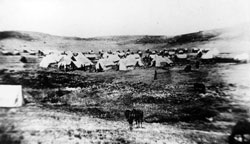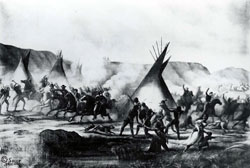We’ve launched a new web portal! Visit findhistory.nd.gov to search our collections.
Due to a road closure, the Killdeer Mountain Battlefield State Historic Site is temporarily closed.
The country through which Sibley and Sully marched was occupied; Native Americans had lived in and made use of this land for thousands of years. The region was divided into fluid territories in which particular groups could claim dominance for extended periods of time. The Native American groups and their approximate territories as they existed in the late 1850s and early 1860s are identified in the map on pages 182-183 in A Traveler’s Companion to North Dakota Historic Sites Third Edition. In general much of the eastern portion of what would be North Dakota was claimed by the Dakotas. The Yanktonais claimed much of the land between the James and Missouri Rivers. Lakotas ranged across the lands west of the Missouri. None of these areas were occupied by one group exclusively. Many Dakotas and Lakotas had joined their Yanktonai relatives hunting for buffalo. Sibley and Sully would encounter members of all these groups as they marched across the territory.

Sibley’s forces reached Dakota Territory near Big Stone Lake on June 24, 1863. They entered present-day North Dakota on July 2 southeast of Lake Tewaukon and headed northwest towards Devils Lake (see Camp Buell, Camp Weiser, Camp Sheardown, and Camp Corning). By July 17 Sibley had learned that the fugitive Sioux had left the Devils Lake area and were moving toward the Missouri River. In order to increase his army’s mobility, Sibley deposited unneeded baggage, surplus supplies, and disabled men and animals at Camp Atchison and continued the pursuit at a faster pace (see Camp Atchison, Camp Kimball, and Camp Grant, and Lake Johnson).
After battles on July 24 at Big Mound (see Big Mound Battlefield and McPhail’s Butte Overlook and Camp Whitney), July 26 at Dead Buffalo Lake, and July 28 at Stoney Lake, Sibley pursued the Sioux to the Missouri. Native warriors engaged Sibley’s troops as their families successfully escaped across the river on July 30. After waiting two more days in hopes of a rendezvous with General Sully’s troops, Sibley, his command short of food and his men exhausted, returned to Camp Atchison. On August 12, 1863, they headed home to Minnesota (see Camp Arnold, Buffalo Creek, and Maple Creek Crossing).
While Sibley waited for Sully at the Missouri River, Sully waited for his steamboats at Fort Pierre (at present-day Pierre, South Dakota). Sully’s arm of the campaign was plagued by a succession of delays. The biggest factor in the command’s late departure was a prolonged drought that prevented the expedition’s steamboats from moving on the uncommonly low water levels of the Missouri River. On the July 25 rendezvous date, Sully’s troops had just arrived at Fort Pierre and were still three weeks ahead of the steamboats. In mid-August, Sully, desperate to advance, loaded the available supplies onto borrowed wagons and marched overland toward Devils Lake with rations adequate for a mere twenty-three days.
In late August, long after Sibley had departed for Minnesota, Sully’s command reached Long Lake, southeast of present-day Bismarck. Realizing that he had missed Sibley, Sully still hoped to catch up with the Sioux. Captured informants reported that the Sioux had escaped Sibley’s army by crossing the Missouri, but had returned after Sibley departed and had moved eastward to hunt buffalo for winter provisions. Sully turned his army eastward toward the James River.
 On September 3, 1863, a scouting party discovered an Indian village near Whitestone Hill. The soldiers stalled the Indians’ escape long enough for Sully to bring his main force into battle position. The confrontation at Whitestone Hill is considered to be the bloodiest attack by whites on Native Americans in eastern North Dakota. Twenty-three soldiers and an estimated one hundred to three hundred Indians were killed, including many women and children. Another 158 people were captured, and most of their food, shelter, tools, weapons, and transportation were destroyed, leaving the survivors destitute in the face of the coming winter (see Whitestone Hill). With his mission essentially accomplished and supplies dangerously low, Sully and his men returned to winter quarters, thus ending the 1863 field campaign.
On September 3, 1863, a scouting party discovered an Indian village near Whitestone Hill. The soldiers stalled the Indians’ escape long enough for Sully to bring his main force into battle position. The confrontation at Whitestone Hill is considered to be the bloodiest attack by whites on Native Americans in eastern North Dakota. Twenty-three soldiers and an estimated one hundred to three hundred Indians were killed, including many women and children. Another 158 people were captured, and most of their food, shelter, tools, weapons, and transportation were destroyed, leaving the survivors destitute in the face of the coming winter (see Whitestone Hill). With his mission essentially accomplished and supplies dangerously low, Sully and his men returned to winter quarters, thus ending the 1863 field campaign.
In 1864 General Sully returned to the Upper Missouri, establishing Fort Rice on July 7, 1864. Almost two weeks later he led his expedition away from the new fort, escorting a wagon train of gold seekers en route to Montana. Learning of the presence of a large group of Sioux, Sully left the immigrants behind at Sully’s Heart River Corral and proceeded to Killdeer Mountain, where a large village of mostly Lakota and Yanktonai people were attacked, many killed, and winter supplies destroyed. Returning to the Heart River encampment, Sully led his troops and the wagon train west to the Yellowstone River, crossing the Badlands. Warriors from Killdeer attacked and harassed the column in retaliation, taking advantage of the Badlands landscape. As Sully and his men struggled west to the Yellowstone River, where they expected to find steamboats with supplies, the Sioux engaged them in a running skirmish known as the Battle of the Badlands. Low on food and water for animals and men, the soldiers reached the steamboats on August 12 and headed downstream to Fort Union, near the junction of the Yellowstone and Missouri Rivers. Lacking sufficient horses or supplies, and with his solders exhausted, Sully ended the campaign and returned down river. The final conflict ignited by the 1864 Sully campaign occurred in September, when Lakota warriors encountered another wagon train crossing their territory, resulting in the siege of Fort Dilts. In 1865 Sully and a small force of cavalry journeyed again through much of the region they had crossed the year before. This time Sully encountered few Indians and fought no battles. The Dakota military campaigns of the 1860s had ended.
Address:
612 East Boulevard Ave.
Bismarck, North Dakota 58505
Get Directions
Hours:
State Museum and Store: 8 a.m. - 5 p.m. M-F; Sat. & Sun. 10 a.m. - 5 p.m.
We are closed New Year's Day, Easter, Thanksgiving Day, and Christmas Day. We are closed at noon Christmas Eve if it falls on Mon.-Thurs. and are closed all day if it falls on Fri.-Sun.
State Archives: 8 a.m. - 4:30 p.m. M-F, except state holidays; 2nd Sat. of each month, 10 a.m. - 4:30 p.m. Appointments are recommended. To schedule an appointment, please contact us at 701.328.2091 or archives@nd.gov.
State Historical Society offices: 8 a.m. - 5 p.m. M-F, except state holidays.
Contact Us:
phone: 701.328.2666
email: history@nd.gov
Social Media:
See all social media accounts